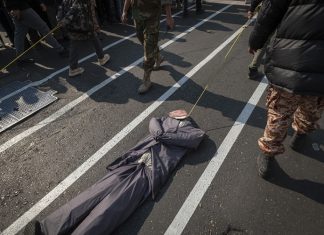The Iranian government this month rolled out its e-learning app “Shadi” (happy) as part of its broader education continuity plan to provide remote teaching to elementary and high school students who, under the stay-at-home directive, do not attend schools during the coronavirus epidemic.
The app has, however, been riddled with technical glitches that have prevented people from downloading it. Also, critics of the program have been quick to point out that a vast number of students from low-income families and in the rural regions of the country cannot take part in the e-learning program because they do not own computers or tablets.
Iranian officials have, however, hailed the app as a success, insisting that the government is addressing the technical issues and economic disparities that have prevented many students from taking part in the distant-learning program.
According to some reports, 5 million students in the country do not have access to the internet or own a smartphone. That is 30 percent of all the elementary and high school students in the country. Only around 15 percent of all the students can reportedly take advantage of the Ministry of Education’s online learning scheme.
To enable those who did not have a birth certificate to enroll in schools, the Ministry of Education rolled out the “Educational Support ID Card” in February 2019. Students, however, need a national ID number to register onto the Shadi distant-learning app, which automatically excludes children who do not have a birth certificate.
During a meeting with the Minister of Education, Mohsen Haji Mirzaei, on April 10, President Hassan Rouhani praised teachers across the country for their efforts to educate their students despite school closures.
[aesop_image img=”https://kayhanlife.com/wp-content/uploads/2020/04/online-school-iran.jpg” panorama=”off” credit=”kayhan london” align=”center” lightbox=”on” captionsrc=”custom” captionposition=”left” revealfx=”off” overlay_revealfx=”off”]
“Students are the country’s assets, and their education should not suffer because of the epidemic,” President Rouhani was quoted by Tehran-based Khabar (news) online news agency as saying. “We should use social media to prevent any disruption to the education system and reassure parents, students, and teachers.”
In an interview with the IRTV1 nightly news program on April 16, Mr. Haji Mirzaei said his ministry had launched the education app Shadi in early April, and many elementary school students had enrolled in the program already.
“According to our data, 8 million people have downloaded the app Shadi (a social network for students) so far, and 2.2 million students have registered in the program,” Haji Mirzaei noted. “Also, 1.5 million learning groups and 510,000 virtual classes have been formed. According to the data, 150 million messages and 60 million files have been exchanged and uploaded in the past three days.”
“The coronavirus pandemic disrupted our education system, which naturally worried President Rouhani, the Education Ministry and parents,” Haji Mirzaei said. “Fortunately, we mitigated the situation with the help of the IRIB’s Learning TV channel and our teachers on social media.”
“Our technical teams are continually improving the Shadi app, ensuring that it can work smoothly. They have promised to speed up the download, make it even faster than some international texting apps,” Haji Mirzaei explained. “Staying safe on social media was also a major concern, so we designed this dedicated learning app for our students,” Haji Mirzaei added.
Speaking to the Iranian Labor News Agency (ILNA) on April 20, Abolhassan Haghighi, the Deputy Education Minister for the northeastern province of Khorasan Razavi, said: “The most significant aspect of Shadi social network for students is the ability for teachers and students to interact with each other directly. The app is a virtual classroom that helps to hold the attention of first graders.”
“Some students do not have access to the internet, because of their geographical locations or social conditions,” Mr. Haghighi, who is in charge of the elementary school curriculum in the province, noted. “To ensure that their education does not suffer, we will provide all the relevant textbooks to children in tribal communities and rural regions in the province in the coming weeks. We will distribute the material in line with the health and safety guidelines.”
While many students and their families live in remote areas and do not have access to the internet, others are poor and cannot afford a computer.
Speaking to reporters on April 20, Ehsan Gohari, the head of the Education Department for the northeastern province of Golestan, said: “Some 90 percent of the province’s schools and 42 percent of teachers have now connected to the Shadi app. However, only 20 percent of the students have signed up for the program. We need to do a better job of informing people about this app.”
“We expect more families to download the app onto their smartphones,” Mr. Gohari noted. “Supervisors will send textbooks and all the relevant course studies to students who cannot access the internet or do not have a television. They will also supervise all the lessons. We hope these students’ studies will not be disrupted.”
Kayhan Life recently spoke to several teachers and university students, who wished to remain anonymous, about the government’s online learning scheme.
A member of the Iranian Teachers’ Trade Association told Kayhan Life: “They have extended School closures twice since the end of January. The Ministry of Education did not have a plan for remote-learning until early March. Many teachers started remote-teaching on WhatsApp and Telegram. So teachers had already been working with students online by the time the ministry announced its plan to launch an e-learning app in early March.”
“A few days before Nowruz [the Iranian New Year, i.e. March 20], the ministry banned teachers from using WhatsApp and other foreign-based services. They introduced a few domestic messaging platforms. The ministry warned that teachers must use only those domestic messaging services,” the teacher noted. “There are 60 teachers at our school, of which 40 refused to use these services, citing a problem with their security and privacy settings. They said that it was easy for others to eavesdrop on their conversations. The ministry was, therefore, unable to stop teachers from using WhatsApp and Telegram for e-learning.”
“The [Shadi] app cannot serve all the teachers and students in the country,” the teacher explained. “We could not use it effectively since it was launched in the first week of April. It is a flawed program. We, however, continue teaching our students, using WhatsApp and Telegram.”
“Many socially disadvantaged students and those living in remote regions of the country do not have access to online classes,” the teacher pointed out. “On average, between10 and 12 students are always absent from these virtual classes because they do not have a smartphone, a computer, or a tablet or access to the internet. Also, many students in trade schools cannot take part in virtual classes because the bulk of their studies happens in workshops that are closed now.”
“Teachers and school principals are shouldering the bulk of the online teaching at the moment,” the teacher said. “Although schools are closed, we must report for work every day. We also spend much time at home preparing online lessons for our WhatsApp and Telegram classes. We work 16 hours a day. Also, we have to pay for the internet out of our pockets.”
“Technology has impacted every aspect of our lives, including the education system, even before the coronavirus outbreak. Recent events have, however, delivered a massive blow to our education system because it lacks a strong foundation needed for adapting to changing conditions,” the teacher argued. “It has led to increased inequality in education in the country because many children cannot access the internet. The education system completely ignores them.”
Most universities have not offered a clear alternative plan for their students since closing two months ago. Many students at universities that offer online courses cannot install and download the programs.
A postgraduate student at the Teran University’s School of Political Science told Kayhan Life: “There were no classes until last week when the university added the online learning program which comprised a 14-page PDF file. It took most of us a long time to open the file and connect to the virtual classroom. We could not see or hear our professor that well. The fonts for the chatroom were too small, and many students did not even find the online classroom. We told our professor we would not use the program. Our professors, who are in the WhatsApp group, use audio files to teach their courses; otherwise, we read the textbooks and forward our questions to them.”
“Students who go to night schools or stay at the university dormitories have paid tuitions, but they can attend classes. However, the university will not refund their money. The students can cancel the current term but lose the money all the same,” the student added.
A veterinarian student at the Islamic Azad University of Shahrekord, the capital of the southeastern province of Chaharmahal and Bakhtiari, told Kayhan Life: “We did not have a full school term year this year. The coronavirus outbreak occurred at the start of the second term in the middle of February. We had, however, canceled all classes before then. Many professors have drafted no online courses yet. We do not know what they will do about lab courses.”
“There are no set schedules for the online courses,” the student noted. “Also, one professor has insisted that everyone should use a domestic app. Students have, however, refused to download the app because of privacy and security concerns. Another professor told us to read the textbooks, which is fine, except he is getting paid to teach. Another teacher complains all the time about having to pay for his broadband.”
“Many professors are as unhappy as the students about having to use a dodgy app to teach classes,” the student added. “I have taken 22 credit hours in this term, but do not know what will happen. The university has not told the students about the final exams for this term.”
This article was translated and adapted from Persian by Fardine Hamidi.





